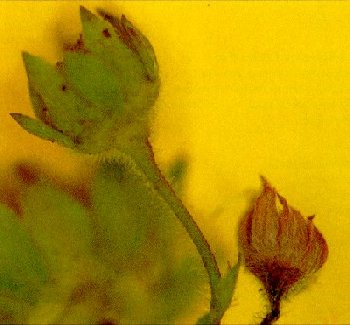Clipper Weevils

Biology
The adult clipper weevil is a small (2-3 mm long), dark reddish-brown weevil. It has rows of tiny pits and two small white spots with dark centres on its back. Its chewing mouthparts extend into a long snout that is about one-half its body length. The legless larvae are also quite small (about 2 mm long). The grubs are white to yellowish-white, with curved, thick bodies.
Symptoms Of Damage
Look for holes in the petals of the flowers, chewed buds, and flower stems that are chewed or "clipped" almost to the point of detachment and left dangling. The dead, straw-coloured section is easy to see against the green of the plant.
Monitoring
Strawberry fields should be monitored for clipped petioles on a weekly basis, beginning in May with the early blooming varieties. Concentrate on field edges closest to woodlots and shelterbelts.
Economic Thresholds
One or two clipped buds per metre of strawberry row is grounds for control. Note that it may not be necessary to treat the entire field if the weevils are found to be localized along a field margin.
Comments
Minimizing the amount of trash in the fields in mid-to late-summer and separating new plantings from old, infested plantings may prevent new infestations. Vigorous tillage of old beds after the final harvest (while the clippers are still pupating) will reduce the movement of clippers from these infested fields to non-infested fields and to nearby overwintering sites.

